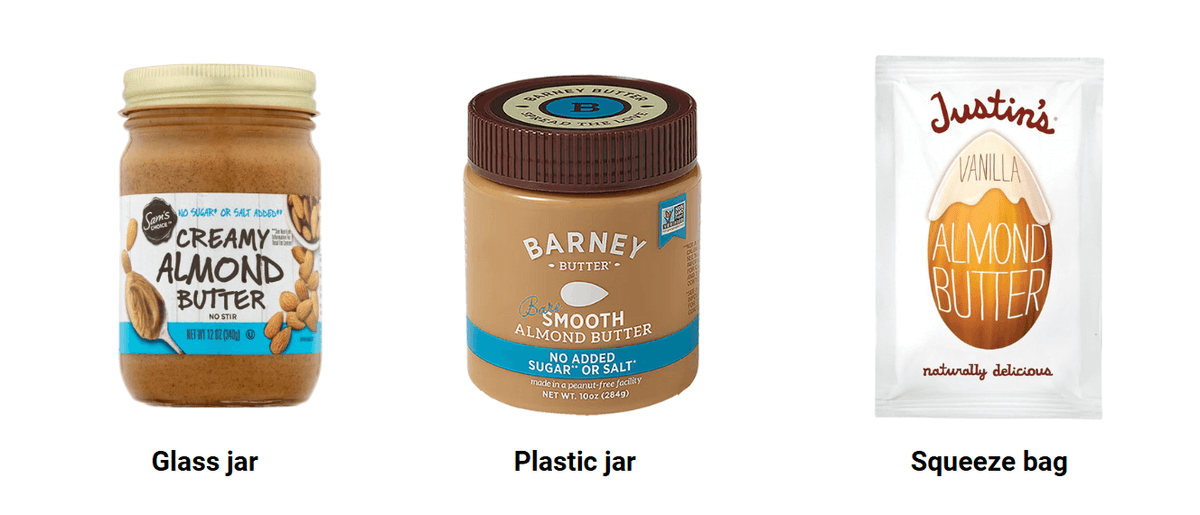In almond paste production, raw materials account for the largest share of total costs. Almonds themselves are expensive, and even small product losses during processing or packaging can significantly reduce profit margins. Furthermore, almond paste is a highly viscous material , placing higher demands on equipment . Standard pumps, long pipes, or poorly designed valves can all lead to residue, leaks, or difficulty in cleaning, all of which create hidden costs in production .

Almond paste can be filled efficiently using a filling and packaging machine designed for high viscosity products. Designing short, large-diameter piping, integrating anti-drip filling valves, and CIP/SIP-friendly connections, combined with high-precision filling and a modular production layout, can increase production speed while reducing giveaway losses.
Almond Butter Cost Factors
The production cost of almond paste depends on several key factors:
- Raw materials : The main cost driver, every gram counts.
- Product loss : residue in pipes, overfill, spillage and rework.
- Labor and downtime : Time wasted during cleaning, changeover, or troubleshooting.
- Equipment depreciation : The long-term cost of investing in machinery.
Fluid dynamics of high-viscosity products
Almond paste behaves very differently from low-viscosity liquids. It flows slowly, forms laminar layers , and often clings to surfaces, leaving residue. Equipment not designed for this material can experience backflow, blockages, or poor sealing . Adding inclusions such as brittle particles can make conveying and filling even more challenging. Small crevices or sharp edges can trap solids, making cleaning more challenging. Understanding these characteristics is crucial for selecting the right equipment.
Factors affecting almond paste filling and packaging production line
Positive displacement pump
Unlike centrifugal pumps, which are designed for free-flowing liquids, piston and gear pumps are more efficient at handling high-viscosity almond paste. They provide precise volume control, strong suction, and resistance to clogging. Their precise metering capabilities ensure that every jar is filled evenly, minimizing costly spillage.
Short-distance, large-diameter pipelines
The longer and narrower the pipe, the more product will be lost as residue. Almond paste production lines should use short pipe diameters to reduce pressure loss, avoid dead corners, and minimize product residue.
Anti-drip filling valve
Special valves with scrapers or a suck-back function prevent the almond paste from dripping after filling. This not only saves material but also improves the cleanliness of the container and reduces the need for manual cleaning.
CIP and SIP compatibility
Downtime is costly. Quick-disconnect fittings and CIP (cleaning-in-place) circuits allow cleaning of lines without complete disassembly. For even higher hygiene requirements, integrated steam SIP (sterilization-in-place) ensures compliance and reduces labor costs.
The almond paste canning and packaging process requires meticulous control to keep the equipment running smoothly . Temperature regulation can reduce viscosity and improve flowability. However, overheating can damage the almond paste's natural flavor and nutritional content, so heating should be limited to safe levels. A stirring element can also be added to the filling hopper to maintain the stability of the material. Cleaning can be done with hot water, steam, or enzyme cleaners, depending on the type of residue.
Frequently Asked Questions and Answers
How to shorten the cleaning time of highly viscous materials?
The CIP-friendly design, including short pipes, quick connectors and minimal dead space, shortens cleaning cycles and reduces waste.
Do I need to heat the system to reduce viscosity?
Heating helps it flow, but it must be carefully controlled. Overheating can destroy flavor and nutrients.
How to avoid raw material loss during small batch production changeover?
Design to minimize residue and employ take-back strategies to ensure remaining product is collected and not wasted.
conclusion
The high cost of almond paste stems primarily from its expensive core ingredient: almonds. Therefore, minimizing waste, from the mixing tank to the can, is crucial. Traditional equipment isn't designed to handle almond paste's high viscosity, leading to residue, dripping, cleaning difficulties, and inaccurate filling, all eroding your profit margins.
Investing in a filling line tailored for almond paste is not just an equipment expense, but also a strategic cost control measure.
- High-precision metering technology ensures consistent weight and eliminates "gift" losses.
- Short-distance large diameter pipes & anti-drip valves minimize pipe residue and overflow.
- The efficient CIP/SIP system significantly reduces downtime, cleaning water and labor costs.
Every kilogram of almond paste you save translates directly into significant profit growth and stronger market competitiveness. This makes our advanced packaging technology your most powerful weapon against high raw material costs.
Contact us today for a custom assessment of your almond butter production line.
